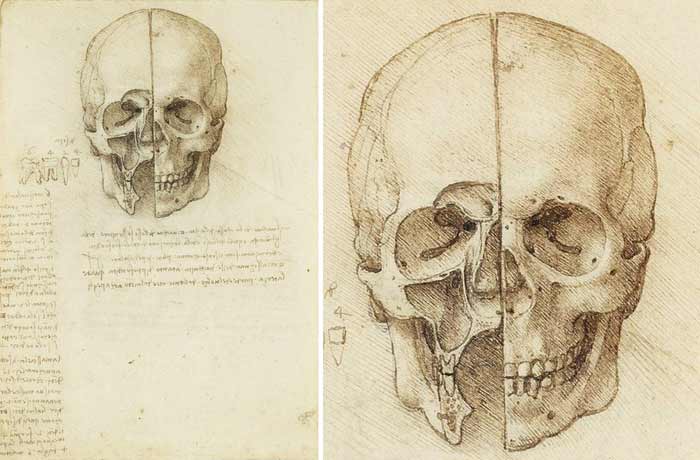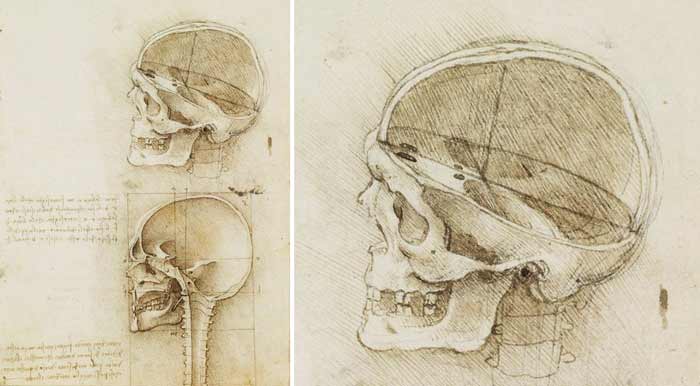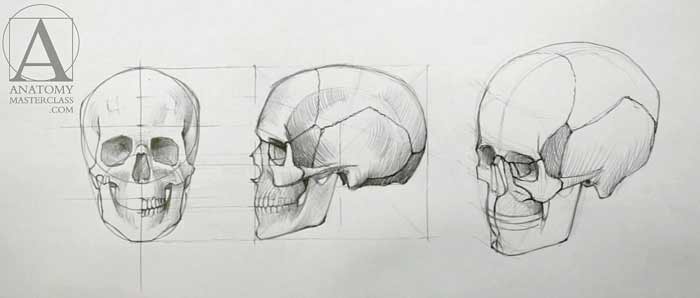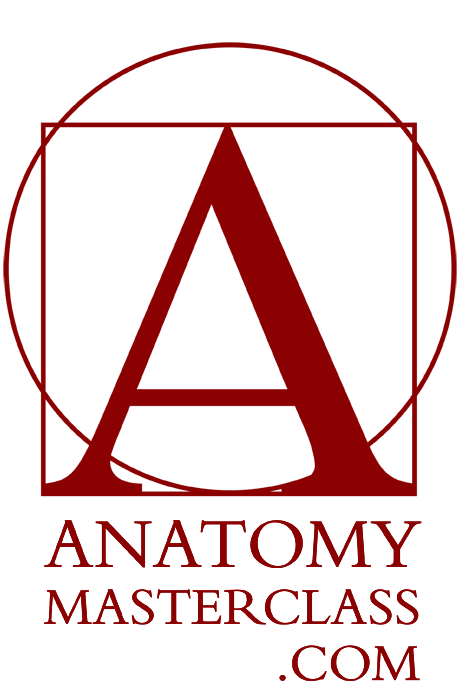How to Draw a Skull
How to Draw a Skull
Anatomy Lesson 5 – Part 1
In this video lesson, you will discover how to draw a skull in a realistic manner.
You will also find out how to draw a skull with the correct proportions.
How to Draw a Skull step-by-step
When it comes to the question of “how to draw a skull”, in frontal view, there is a virtual vertical line, which represents the main axis of symmetry.
The skull can be divided in half, and the top half is sub-divided into three equal parts.
The bottom half is also sub-divided into three parts. The line that goes through the second mark from the top, serves as an axis for a circle.
The length of the horizontal axis is equal to two thirds of the skull’s height. In other words, the top part is twice as large as the bottom one.






With this proportion in place, we can draw a circle, with the help of vertical and horizontal axes.
Now, you can draw another circle with the center in the middle of the lower three marks; that is, one and a half marks from the bottom edge.
These two circles overlap each other. The combined shape of these circles indicates the outline of the skull.
The larger circle represents the cranium section of the skull. This section contains and protects the most vital organ in the human body – the brain.
The lower edge of the cheekbones is located one third of the way from the lower edge of the skull – two marks in our drawing.
The eye socket is not round. It has a characteristic trapezoidal shape, which is tilted diagonally.
The top border of the nasal cavity lies exactly in the middle of the skull, right on the top point of the smaller circle.
The bottom edge of the nasal cavity aligns with the bottom point of the larger circle, one third of the way up from the bottom edge of the skull.
The inside surface of the eye socket is not spherical, but rather pyramidal.
The lower jawbone is called the mandible.
Proportionally, it fits into the smaller circle. The angle of the mandible and the bottom edge of the jawbone touch the outline of the circle.
The part of the jawbone, which veers upward, is called the ramus.
At the top it has two spikes – one is called the condylar process, which is part of the jawbone joint; and another one is coronoid process, where the muscle that lifts the jawbone is attached.
The upper dental arch is called the maxilla.
When you learn how to draw a skull, also do skull sketches in profile.
When viewed from the side, the skull fits into a square.
In this view, the ear hole is located just below the square’s center point.
The virtual line that runs from the brow ridge to the ear-hole separates the bones of the cranium from the facial bones.
The ramus of the jawbone is located just in front of the ear-hole.
The nasal bone ends right in the middle of the skull’s height. The nasal cavity takes one sixth of the skull’s height.
The dental arch has a characteristic curvature, marked here with a red semicircle.
The protruding part of the jawbone is called the mental protuberance. It is unique to humans; no other living creature has such a distinctive feature.
The zigomatic arch is like a bridge that starts above the ear-hole and goes forward, where it merges with the cheekbone.
The temple line is an important mark for a portrait artist. It separates the vertical planes of the temples from the top planes of the skull.
The eye-socket, which is called the orbit, is located in the middle of the skull.
The mastoid process is another important landmark for an artist. This where certain prominent neck muscles attach to the skull.
It is also good practice to draw the skull in three-quarters view when learning how to draw a skull.
A proficient portrait artist must know the following axes and virtual lines to establish the masses of the head correctly.
The brow ridge line helps to establish the position of the eye sockets correctly.
The line marking the base of the nose establishes an axis for the nose and cheekbones.
The chin line marks out the bottom edge of the skull.
The curvature of the temple line replicates the direction of the central line.
Other virtual lines you may find helpful when doing constructive drawing of the head are:
- The plane of the forehead
- The contour of a face
- The plane of cheekbones
- The planes and angles of the jawbone
- And other lines connecting various points of planes
When it comes to the topic of how to draw a skull, you also need to know the bones of the skull.
In total, there are 29 bones in the human skull. Teeth are not counted here as skull bones.
The cranium consists of 8 bones, and the facial section of the skull contains another 21 bones, including the small bones of the inner ear.
The frontal bone forms the forehead and the upper wall of the eye sockets.
The two maxilla bones form the upper jaw, the side of the nose, and the lower wall of the eye sockets.
The two cheekbones are called the zygomatic bones. They also serve as the outer walls of the eye sockets.
The Sphenoid bone is only partially visible on the outer wall of the cranium. Most of this bone forms the cranium floor and the rear walls of the eye sockets.
There are two sets of paired bones that form cranium walls. The Temporal bone covers the side and part of the floor of the cranium; the parietal bone covers the upper parts of the cranium walls and its roof.
Inside the eye socket there are two bones that form the inner wall.
The lacrimal bone is the smallest bone of the face, as well as the most fragile.
The ethmoid bone separates the nasal cavity from the brain.
The lower jawbone, or mandible, is the only movable bone in the skull. It is also the strongest one.
There are many other bones in the skull…
[ The full lesson is avaibale to Anatomy Master Class members ]
To learn more about How to Draw a Skull, enrol in the Anatomy Master Class
Simple Pricing, No Surprises
One-time payment - Only $97 USD
ENROLL NOW



